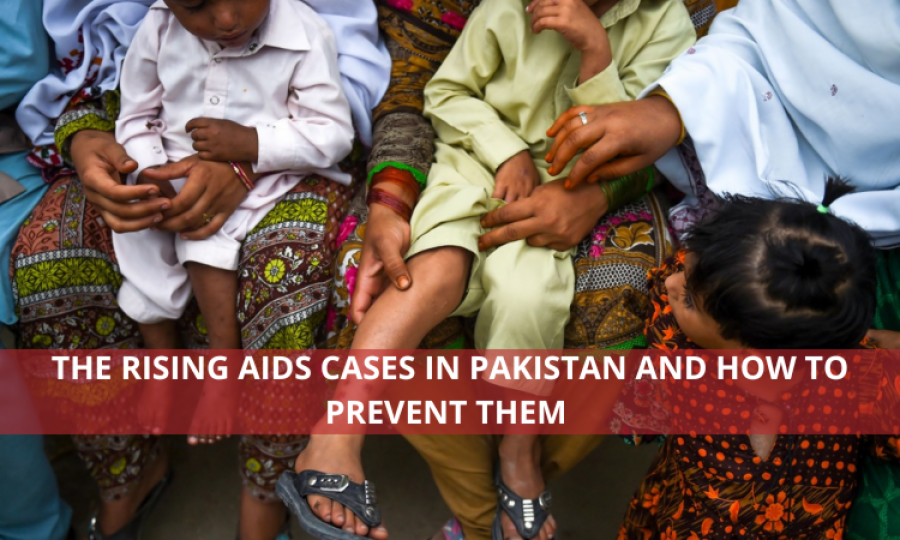The Rising AIDS Cases in Pakistan and How To Prevent Them

HIV is a virus that attacks the immune system in the human body and, if left untreated, can progress to AIDS. In AIDS, a person is extremely susceptible to opportunistic infections as the immune system is no longer functioning adequately. Thus, there is a limited life expectancy of 3 years in untreated, end-stage patients. In recent times, there has been an alarmingly high number of reported cases of HIV-positive people in Pakistan. This has become a major health issue that requires immediate attention.
Statistics
During the last 10 months of 2022, 9,773 people have reportedly tested positive for HIV in Pakistan. Official data shows that Punjab has the highest number of cases (6,106), followed by Sindh (2,097), and Khyber Pakhtunkhwa (815) recorded from January 1 to October 31, 2022. Balochistan has reported 316 new cases while Islamabad Capital Territory has reported 496 new cases.
According to health experts, 65% of patients did not come back for treatment due to the troublesome behaviour of their healthcare providers. Between 2010 and 2020, there was a reportedly 84% increase in HIV cases.
Causes
HIV can be transmitted through blood, semen, rectal fluids, vaginal fluids, and breast milk. The rising cases of HIV/AIDS in Pakistan can be attributed to:
● Low levels of awareness in the common public
● Poor infection prevention and control
● Problematic behaviour of healthcare providers
● Low levels of monitoring in healthcare systems
● Use of contaminated medical equipment
● Increased intravenous drug usage
● Men having sex with men (MSM)
● Associated stigma which prevents reporting
● Contaminated blood transfusions
● During pregnancy, labour, or delivery from an HIV-positive mother to their baby
● Breastfeeding by HIV-positive mothers
● Unsterilized equipment used for tattoos
Symptoms
Early symptoms of HIV infections can start to show up within a couple of weeks or one to two months after exposure. Symptoms may include:
● Sudden weight loss
● Recurring fever
● Unexplained and extreme tiredness
● Swelling of lymph nodes in armpits, groin, or neck for extended periods
● Diarrhoea lasting more than a week
● Sores of the mouth, anus, or genitals
● Pneumonia
● Headache
● Muscle aches
● Joint pain
● Rash
● Shingles
● Recurrent oral or vaginal yeast infections
● Menstrual cycle changes
● Pelvic inflammatory disease
Prevention
● Screening for HIV
● Pre-exposure and post-exposure prophylaxis
● Removing the stigma attached to the disease
● Increased infection prevention and control
● Increased monitoring in healthcare setups
● Avoid sharing/reusing needles
● Use of protection, like condoms, during intercourse
● Use of formula milk for babies of HIV-positive mothers
Treatment
While HIV cannot be fully cured, it can be managed through antiretroviral therapy (ART). This involves the consumption of a combination of drugs for HIV every day, as prescribed, and is the recommended course of action in all HIV-positive patients. These medicines help to halt the replication of the virus in the body. Thus, it leads to the immune system repairing itself and preventing further damage. The treatment can take six to twelve months to bring the virus under control. Ultimately, it helps a person live a healthier and longer life.
Advertisement
Trending
Popular
Hair loss: Discovery uncovers key stem cells that could reverse ...
-
Broccoli sprout compound may help lower ...
11:31 AM, 25 Feb, 2025 -
Gas Pain vs. Heart Attack: How to tell ...
09:00 PM, 22 Feb, 2025 -
Coconut oil supplement shows promise ...
08:00 PM, 20 Feb, 2025 -
Normal vitamin B12 levels may still ...
05:00 PM, 19 Feb, 2025



